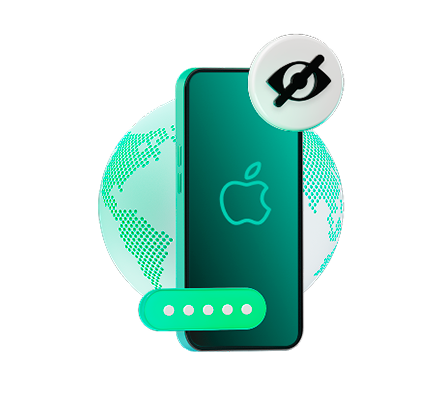How to keep your account from getting hacked
What for: So you don’t get hacked.
If you use a short and simple password, cybercriminals can guess it and hijack your account. A long and complex password is more secure. Use a strong password that:
- Is at least 8 characters long;
- Contains lowercase and uppercase letters, numbers, and special characters ($, @, etc.);
- Is not an actual word or easy-to-guess phrase;
- Is not the same as your passwords for any other accounts;
- Does not consist of information that strangers could easily find out (your name, date of birth, pet's name, and so forth — or those of your friends or relatives).
To change your password:
- Open the menu by tapping the icon in the upper left corner of the screen;
- Go to the Settings and privacy section;
- Select Your account;
- Tap Change your password;
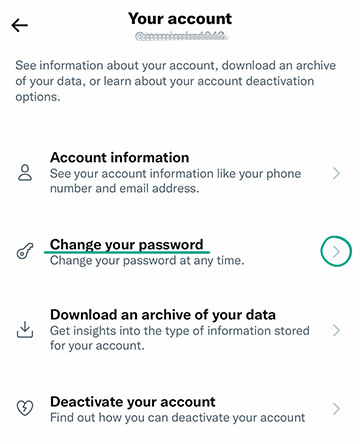
- Enter the current password for your X(Twitter) account;
- Enter a new strong password twice;
- Tap Done.
What for: So you definitely don’t get hacked.
X(Twitter) can prompt you to enter an additional one-time code every time you log in to your account. If cybercriminals attempt to hack your account, they will not be able to log in without this code. The code can be received in different ways: via a text message (SMS) or using an authentication app.
To enable two-factor authentication:
- Open the menu by tapping the icon in the upper left corner of the screen;
- Go to the Settings and privacy section;
- Select Security and account access;
- Tap Security;
- Select Two-Factor Authentication;

- Select the authentication method:
- Text message — receive a one-time code via SMS;
- Authentication app — a one-time code is generated in a dedicated app such as Authy or Google Authenticator;
- Security key — a one-time code is generated using a USB authorization device such as YubiKey;
- Follow the on-screen instructions;
- When two-factor authentication is enabled, you will see a dialog box with a one-time backup code. Copy it and store it in a safe place. You need this code to access your account if you lose your phone. Note that you can log in using the backup code only in the Web version of X(Twitter).
You can get the code later by selecting Backup code in the Additional methods section.
A hardware security key can be used only with the supported mobile device or the web version of X(Twitter) and only in combination with two-factor authentication via SMS or a mobile app.
Downside: If you use SMS-based authentication, X(Twitter) can use the specified phone number for targeted ads.
What for: To make sure that you are the only one who has access to the account.
You can view the history of logins and other activities carried out on behalf of your account. If you detect any suspicious activity, immediately change your password and terminate all active sessions except the current one.
To check the security of your account:
- Open the menu by tapping the icon in the upper left corner of the screen;
- Go to the Settings and privacy section;
- Select Privacy and safety;
- Scroll down and select Location information;
- Tap See your X(Twitter) data;

- In the browser page that opens, check your personal data and activity history in the Account and Account history sections.

To terminate all active X(Twitter) sessions except the current one:
- Open the menu by tapping the icon in the upper left corner of the screen;
- Go to the Settings and privacy section;
- Select Security and account access;
- Tap Apps and sessions;

- Select Sessions;
- Tap Log out of all other sessions.
What for: Not to reveal your main password to third-party services.
Use a temporary password if you use the X(Twitter) account to log in to third-party services. It lets you log in but expires in one hour. Even if the temporary password ends up in the hands of cybercriminals, they will hardly be able to use it in time.
A temporary password can be generated only after two-factor authentication has been enabled.
To generate a temporary password:
- Open the menu by tapping the icon in the upper left corner of the screen;
- Go to the Settings and privacy section;
- Select Security and account access;
- Tap Security;
- Open Two-factor authentication;
- Tap Temporary password in the Additional methods section;
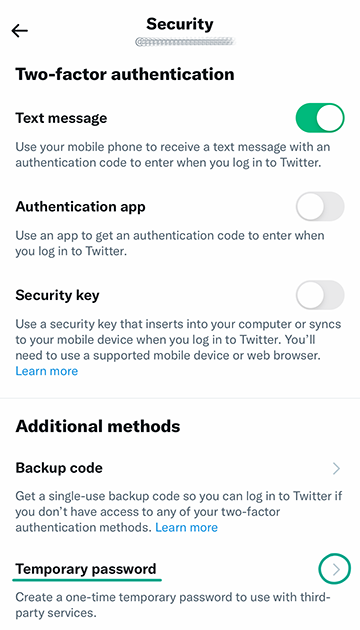
- Use the generated password to log in.
How to keep corporations out of your business
What for: To use device resources sparingly and hide from cybercriminals.
X(Twitter) detects the approximate location of users based on the IP address. However, the app can also collect information about your precise location so you can geotag your posts and view targeted ads and recommendations. Note that if you once geotag your tweet, all your subsequent posts will be geotagged automatically until you disable this feature.
Transmission of geodata increases traffic usage and drains the battery. Information about your location can also help cybercriminals stage phishing attacks.
Precise location tracking is disabled by default, but we recommend checking this setting.
- Open the menu by tapping the icon in the upper left corner of the screen;
- Go to the Settings and privacy section;
- Select Privacy and safety;
- Scroll down and select Location information;

- Go to Precise location;
- Clear the check mark next to Precise location.

The app for iOS does not allow you to remove geotags from previously published tweets. To do so, follow instructions for the web version.
Downside: Third-party services can also geotag your tweets and do not always warn you explicitly.
What for: To minimize the risk of a leak.
X(Twitter) can collect information about your behavior, preferences, interest, and location, as well as other data. You cannot block access to the basic account info. This includes the name of your device, your social network activity and approximate location. This information is used to generate targeted ads and recommendations as well as to form the news feed.
However, X(Twitter) can analyze additional data and info. For example, if you regularly log in to X(Twitter) from your mobile device and visit travel sites on the computer at roughly the same time and both devices are connected to the same network, X(Twitter) can assume that these mobile device and computer belong to you and will begin showing hotel and travel agency ads in the app.
Additional information includes:
- Places you visited and precise geographic coordinates;
- Information about your other browsers and devices, even if you haven’t used them to log in to X(Twitter);
- Information about e-mail addresses and phone numbers that are not linked to X(Twitter) but may belong to you;
- Online browsing history;
- History of views and your interests.
Some of this information is provided by partners of the service. X(Twitter) itself can also share it with third parties. By default, the social network does not collect extended information, but we recommend checking the settings anyway.
To stop the app from collecting and using personalized information:
- Open the menu by tapping the icon in the upper left corner of the screen;
- Go to the Settings and privacy section;
- Select Privacy and safety;
- Scroll down to the Data sharing and off-X(Twitter) activity section;
- Go to Ads preferences, Off-X(Twitter) activity and Location information, and turn off the toggle switches next to:
- Personalized ads
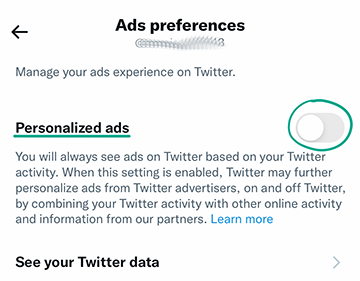
- Personalize based on your inferred identity
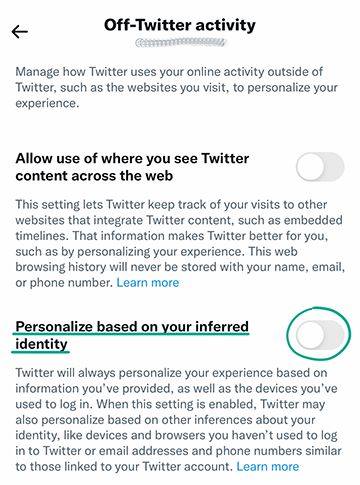
- Personalize based on places you’ve been.
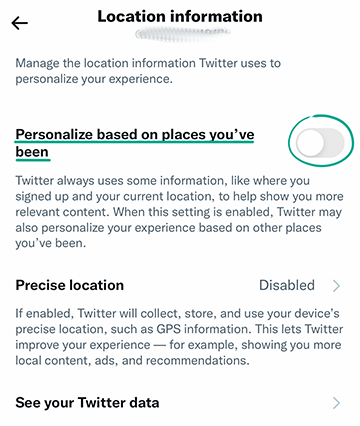
Keep in mind that this does not disable content personalization: X(Twitter) will still continue to do this based on available information about you and your device.
What for: So X(Twitter) has less info about you.
X(Twitter) stores data about your behavior, hobbies, and locations. It then uses such data for targeted ads and recommendations. If you are bothered by targeted ads, you can remove this information.
To remove saved data about your interests and location:
- Open the menu by tapping the icon in the upper left corner of the screen;
- Go to the Settings and privacy section;
- Select Privacy and safety;
- Scroll down to the Data sharing and off-X(Twitter) activity section;
- Select Ads preferences, then See your X(Twitter) data.
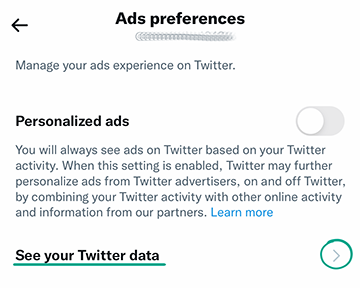
- On the browser page that opens, go to the Interests and adds data section:
- Tap Interests from X(Twitter) and clear check marks next to all items in the list;
- Tap Inferred interests from partners and clear check marks next to all items in the list;
- In the Account history section, select Places you’ve been and tap Remove.
Downside: X(Twitter) can add new information on your interests and preferences based on your social network activity, so we recommend checking this list regularly.
How to defeat spammers and trolls
What for: To keep your peace of mind.
You can stop tweets containing specific words, hashtags, and smiley faces from appearing in your news feed and notifications. This lets you hide unwanted posts.
To configure the filter:
- Open your profile by tapping the menu icon in the upper left corner of the screen;
- Select Settings and privacy;
- Tap Privacy and safety;
- In the Your X(Twitter) activity section select Mute and block;
- Select Muted words;
- Tap Add and type a word or phrase tweets with which you want to hide.
- In the Mute from section, chose where to apply the filter: to the home timeline or the notification feed;
- Choose the type of users to whose tweets the filter will be applied: From anyone or From people you don’t follow;
- In the Duration section, select for how long the filter should be effective;
- Tap Save in the upper right corner of the screen.

By default, it is applied forever to both the home timeline and the notification feed. Also keep in mind that the filter is not case sensitive.
What for: To exclude adult and graphic content from the notification feed.
The app for iOS does not allow you to exclude unwanted content from search results. To do so, follow the instructions for the web version of X(Twitter).
What for: To limit unwanted communication.
By default, only users whom you follow can send you direct messages. However, we recommend checking this setting:
- Open your profile by tapping the menu icon in the upper left corner of the screen;
- Select Settings and privacy;
- Tap Privacy and safety;
- In the Your X(Twitter) activity section select Direct messages;
- Make sure that the Allow message requests from everyone toggle switch is turned off.

This will not affect users with whom you have already started chats. To stop them from sending you direct messages, block them.
Companies and developers may send you direct messages requesting your location or access to media files. They use this information to configure recommendations. Note that this information can be shared with third parties, so treat such requests with care.
What for: Added protection against fraud.
The app for iOS does not allow you to stop other users from adding you to teams using TweetDeck. To do so, follow instructions for the web version of X(Twitter).
How to hide posts from unwanted people
What for: To get rid of unwanted people in the virtual space.
To stop a specific user from viewing your tweets and replying to them or sending you direct messages, you can block this user. The blocked user will not be able to view your profile or contact you.
To block a user:
- Go to the profile of the follower you wish to block;
- Tap the three dots icon in the upper right corner of the screen;
- Select Block @username;
- Tap Block in the window that opens.

The user will not be notified about getting blocked. However, if they visit your profile, they will see that you blocked them. The blocked users can file a complaint against you and view all tweets in which you mentioned them.
You can unblock a blocked user any time (for example, if you blocked the user by mistake):
- Open the menu by tapping the icon in the upper left corner of the screen;
- Go to the Settings and privacy section;
- Select Privacy and safety;
- In the Your X(Twitter) activity section select Mute and block;
- Go to the Blocked accounts section;
- Tap Blocked next to the account name to unblock it.

Keep in mind that if one of your followers shares the link to the photo attached to your private tweet, the image will be visible to all recipients.
What for: To avoid running into somebody you don’t wish to see.
The app for iOS does not allow you to exclude blocked accounts from search results. To do so, follow instructions for the web version of X(Twitter).
How to prevent your personal data from being exposed
What for: To prevent your contact details from ending up in the hands of cybercriminals in the event of a leak.
X(Twitter) can use your phone contact list to suggest you to follow their accounts. The service also uses contact list information to create targeted ads and form your news feed. This information can be shared with third parties, which increases the risk of leaks.
To disable contact synchronization:
- Open the menu by tapping the icon in the upper left corner of the screen;
- Go to the Settings and privacy section;
- Select Privacy and safety;
- Go to the Discoverability and contacts section;

- Tap Remove all contacts to delete previously collected data and confirm;
- Disable the Sync address book contacts option.

After that X(Twitter) will stop suggesting you to follow the accounts of your friends in your contact list.
Note that even after you disable synchronization, the X(Twitter) app will still have permission to access your contacts. To cancel this permission:
- Open Settings on your device;
- Locate and select X(Twitter) in the list of apps;
- Disable the Contacts option.
What for: To keep cybercriminals from learning sensitive information.
By default, your posts are visible to everybody, even people who do not have a X(Twitter) account. Information from posts can help cybercriminals launch phishing attacks. You can limit the visibility of your tweets to everybody except approved followers.
To limit access to your posts:
- Open the menu by tapping the icon in the upper left corner of the screen;
- Go to the Settings and privacy section;
- Select Privacy and safety;
- In the Your X(Twitter) activity section select Audience and gagging;
- Set the check mark next to Protect your Tweets.
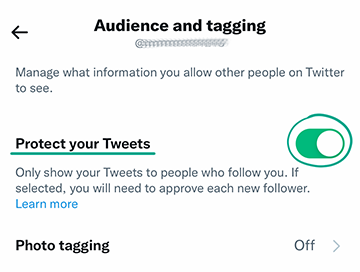
Now X(Twitter) users who want to read your posts will have to submit a request and wait for your approval.
Previously published tweets will remain public.
Also, people who were among your followers at the time when you made your profile private will continue to see your tweets.
What for: To prevent cybercriminals from using such information.
By default, other X(Twitter) users can find your account using your phone number or e-mail address. Information from your profile can help cybercriminals stage phishing attacks, so we recommend disabling this feature.
To stop users from finding your account using your phone number or e-mail address:
- Open the menu by tapping the icon in the upper left corner of the screen;
- Go to the Settings and privacy section;
- Select Privacy and safety;
- Go to the Discoverability and contacts section;
- Turn off the toggle switches:
- Let others find you by your email;
- Let others find you by your phone.

Downside: Other users will have a harder time finding your X(Twitter) account.
What for: To see what information X(Twitter) has on you and create a backup copy of important data.
X(Twitter) can generate for you a file with all your profile data. This will let you find out what kind of information the service collects about you as well as save it in case your account gets blocked, removed, or hijacked.
To download an archive with your data:
- Open the menu by tapping the icon in the upper left corner of the screen;
- Go to the Settings and privacy section;
- Select Your account;
- Tap Your X(Twitter) data;
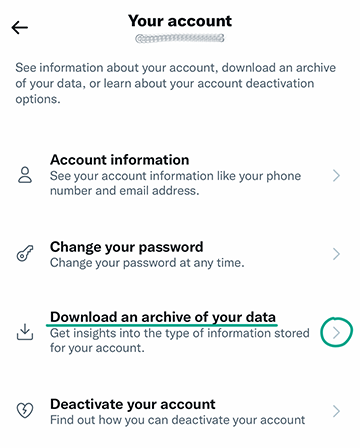
- In the window the opens, go to the Download archive section and enter the password for your X(Twitter) account;
- Tap Request archive next to X(Twitter) and wait for a notification or e-mail;
- After receiving a confirmation message, tap Download archive next to X(Twitter).
Here you can also download data of your Periscope account if you use it for direct broadcasts in X(Twitter).
It may take several days to prepare the archive. A download link will be sent to your e-mail address. Note that you may request a data download up to once every 30 days.
What for: To control who has access to information about you.
By default, all X(Twitter) users can tag you in photos. If you get tagged by a person whom you follow, the tweet will appear in your timeline. In this way, your information can become available to strangers. You can block users from tagging your profile when they post images.
To stop users from tagging you in photos:
- Open the menu by tapping the icon in the upper left corner of the screen;
- Go to the Settings and privacy section;
- Select Privacy and safety;
- In the Your X(Twitter) activity section select Audience and tagging;
- Tap Photo tagging and disable this option.
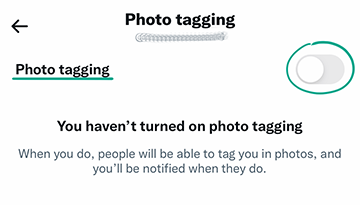
View photos in which you are tagged in the Mentions section in the notification feed (bell icon). If necessary, you can remove the tag:
- Tap the arrow icon to the right of the tweet author's name;
- Select Remove tag from photo;
- Tap Remove again to confirm your selection.
What for: To prevent your personal information from ending up in the wrong hands.
Cybercriminals can use your account data to stage phishing attacks, and X(Twitter) can use it to configure ads and recommendations. You can limit the scope of publicly available information or refrain from specifying your real info.
To change the profile data:
- Open the menu by tapping the icon in the upper left corner of the screen;
- Select Profile;
- Tap Edit profile;
- Tap your profile photo and upload any image that makes it impossible to determine that the account belongs specifically to you;
- In the Name field, enter an alias;
- Remove data from the fields:
- Bio;
- Location;
- Website;
- Tap your birth date at the bottom of the screen;
- Tap Remove birth date and confirm your selection;
- Tap Continue.
- Then tap Save in the upper right corner of the screen.

What for: To minimize the risk of a leak.
If you linked other sites or apps to X(Twitter) (such as apps for finding followers or counting tweets), they can obtain access to your data. In some cases they may also be able to like posts and follow or unfollow accounts on your behalf.
Such sites and apps do not normally inform you explicitly about the specific permissions you grant them.
You can deny third-party apps and sites access to your data in order to rule out any unauthorized activity in your account and lower the risk of data leaks.
To disable access to your account for third-party services and apps:
- Open the menu by tapping the icon in the upper left corner of the screen;
- Go to the Settings and privacy section;
- Select Security and account access;
- Tap Apps and sessions;

- On the browser page that opens, select Connected apps. Block the ones that you do not use:
- Tap the right arrow next to the app;
- Select Revoke app permissions.
How to get rid of unwanted notifications
What for: To avoid distractions.
By default, X(Twitter) sends you notifications about the most interesting activities of other users (in the opinion of the service). If these notifications distract you, you can stop the app from notifying you about activities of specific user categories, e.g. those who have not confirmed their contact details (spammers often avoid doing this to save time):
- Open the menu by tapping the icon in the upper left corner of the screen;
- Go to the Settings and privacy section;
- Select Notifications;
- Turn on the Quality filter toggle switch;
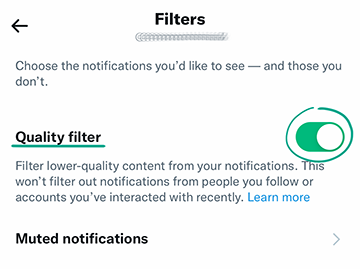
- Tap Muted notifications and select check marks next to:
- You don’t follow;
- Who don’t follow you;
- With a new account;
- Who have a default profile photo;
- Who haven’t confirmed their e-mail;
- Who haven’t confirmed their phone number.
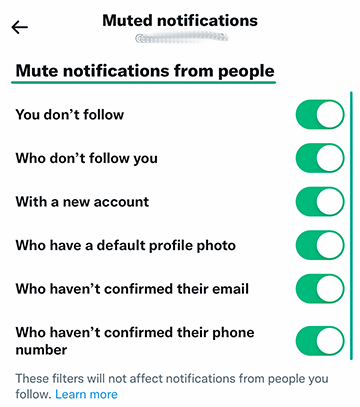
Downside: The filter does not apply to accounts that you follow or with which you recently interacted.
What for: To avoid distractions.
X(Twitter) can send you push notifications, text messages, or e-mails. Some of the notifications are marketing materials about recommended products, including from X(Twitter) partners.
To stop receiving such notifications:
- Open the menu by tapping the icon in the upper left corner of the screen;
- Go to the Settings and privacy section;
- In the Notifications section select Preferences;
- Go to the Email notifications section and turn off the toggle switch at the top of the page.

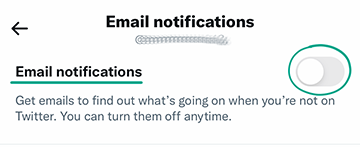
We recommend reviewing other notification categories and disabling those that you do not want to receive.
Downside: Some notifications may contain information about service features and useful tips on using the platform.

